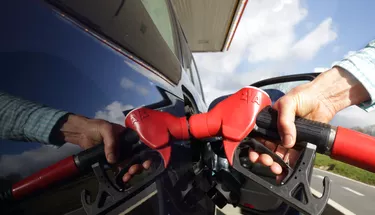
Paying for gas with a credit card provides convenience and documentation for the purpose of tracking expenses. Gas stations offer two options for using a use a credit card – paying at the pump or paying an attendant at the counter.
Paying an Attendant With a Credit Card
Video of the Day
If the gas station situates the attendant behind security glass, the credit card is passed using a drawer. The customer tells the attendant the amount of gas that will be purchased, and the card is charged for that amount. The attendant then returns the card through the drawer, along with a receipt to be signed. The customer returns the signed receipt and goes back to pump the gas.
Video of the Day
There are two processes for paying for gas with a credit card at the counter: swiping or inserting the card using a counter top terminal or handing the card to the attendant for payment. The attendant charges the card for the gas to be purchased, the customer signs the receipt and goes back out to pump the gas.
Paying With a Credit Card at the Pump
Purchasing gas at the pump avoids the walk, signature and paperwork associated with paying at the counter. After swiping or inserting the card, most pay-at-the-pump systems will ask for the ZIP code of the billing address for the card. This is a security measure to prevent the use of stolen or lost credit cards to purchase gas at the pump. After keying in the ZIP code, the customer can start pumping gas.
Beware that identity thieves target pay-at-the-pump terminals for the purpose of stealing credit card information. This is done by installing a device that reads the card information when it is swiped. Having credit card information stolen in this manner can be avoided by paying at the counter instead.
Why Holds Are Placed on Credit Cards
If the amount of gas that will be purchased is unknown when the card is swiped, the gas station can put a hold on the card for a pre-set amount. This ensures that the card being used can cover the amount of the purchase. For example, when a customer paying at the counter intends to fill the tank, a hold will be entered by the attendant. The amount of the hold varies between gas stations, but it can go up to $100 or more, according to WFMY News.
Once the purchased is finalized, the actual amount is charged to the card. The hold usually falls off of the account within 3 to 5 business days. Holds also are placed on pay-at-the-pump transactions.
Using Gas Credit Cards
According to Investopedia, gas credit cards are another way to go when paying at the pump. Much like credit card companies, oil and gas companies offer cards specifically for this purpose as a way to give customers discount on gas prices. These cards are often issued in partnership with a bank and many companies have more than one type of card. They often reward the consumer with a little money off the gas purchased at their stations.
Some cards also offer other rewards, such as cash back on car rentals, airfare, and lodging. Gas station credit cards usually have no annual fees, but they can have higher interest rates than standard credit cards. In some instances, they also can only be used at a gas station.